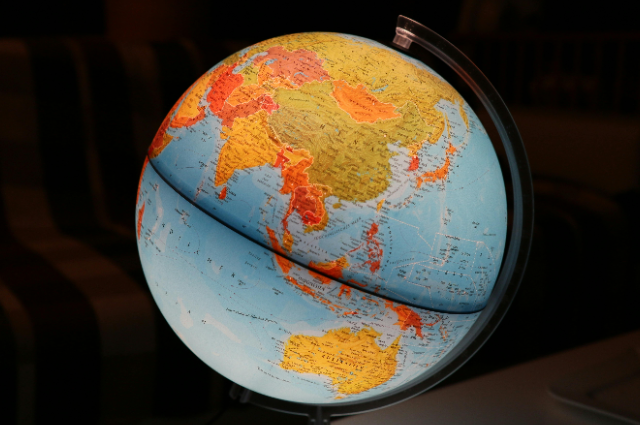
The collision of the Proto-Earth and Theia on the protoplanetary disc of a newly formed star, which we now call sun, gave birth to our planet Earth and its moon. The history of Earth rewinds back to 4.6 billion years ago from the Hadean Eon when the earth was nothing but volcanic activity, pahoehoe, and regular showers of extraterrestrial bodies. The molten rocks eventually subsided beneath the surface of the earth as a result of convection currents, and the relatively cooler materials began to form the crust of the earth, bringing lighter elements like silicon with them. Although the atmosphere was initially composed primarily of hydrogen and helium, volcanic outgassing released water vapor and carbon dioxide, further reducing the temperature.
Subsequently, 4 billion years ago, the Archean Eon began. Zircon crystals and carbonaceous chondrites, two meteors, both saturated with frozen water, impacted the earth and helped construct the hydrosphere together with the volcanic eruptions despite the comet shower's decline. Vaalbara, the first supercontinent, was created as a result of the area's solid lithosphere and comparatively mellow climate. As the land was formed, the submarine volcanoes created ferric hematite, which led to banded-iron deposits on the volcanoes' flanks. Since oxygen was still toxic to anaerobes in water at the time, they benefited from the reduction of oxygen to produce ferric hematite. However, as the iron in the water rusted completely, the oxygen leaked into the atmosphere.
Then began the Proterozoic Eon 2.5 billion years ago, where eukaryotic and multicellular life eventually arose because the circumstances on Earth were finally stabilized. When cyanobacteria first appeared, beginning the process of photosynthesis, and the oxygen released from the banded iron formation was at its highest, "The Great Oxidation Event," took place, resulting in the abatement of carbon and methane –greenhouse gases that absorbed the heat of the sun– in the atmosphere, simultaneously decreasing the temperature. Consequently, the first ice age began 2 billion years ago. As Vaalbarra was separated due to dolerite dikes which prevented the impingement of mantle plumes onto the base of the continental crust, the formation of Rodinia and Columbia; two more supercontinents, took place one after the other. The ozone layer originated in the stratosphere as a result of the bonds created by oxygen molecules in the air, which helped reflect the sun's rays.
Beginning 545 million years ago and lasting to the present, the Phanerozoic aeon also marked the commencement of the Cambrian era. Due to the rise in the seafloor and the appearance of genuine exoskeletons in many species, such as trilobites and echinoderms, the Cambrian explosion, which occurred 541 million years ago, initiated the biggest variety of life in Earth's history. Around 65–250 million years ago, when dinosaurs, amphibians, and trees like gymnosperms flourished, organisms began to wander toward the land, and the age of mammals began. Pangea, the recently formed supercontinent, broke apart, and the tectonic movement resulted in the formation of the modern map. The environment allowed for the gradual rise of apes and humans, making the earth a planet that millions of others couldn't become – habitable.
Habitable it is, but for how long? Water is evaporating and the temperature is increasing, because of the carbon emissions released by humans. If any large-scale action isn’t taken soon, Earth will be forced to undergo several changes, disabling the planet to provide life support. Hence the question is, are we willing to make efforts in order to save what created us, or make plans to escape to Mars?
. . .
References:
- J. Rafferty. “Hadean Eon”, Britannica. 3 October 2022.
- S. Chatterjee.“Archean Eon”. ScienceDirect. 2021
- What Happened in the Archean Eon? [4.0 to 2.5 billion years ago].EarthHow. May 11, 2022.
- S. Chatterjee.“Archean Eon”. ScienceDirect. 2021
- What Happened in the Archean Eon? [4.0 to 2.5 billion years ago].EarthHow. May 11, 2022.
- Holland, H.D.“Early Proterozoic atmospheric change”.Early Life on Earth. 7 July 2011.
- B.F.Windley. “Proterozoic Eon”. Encyclopedia Britannica.2 August 2021.
- T.F.Flannery. “Cambrian explosion”, Encyclopedia Britannica.8 August 2019.
- The Editors of Encyclopaedia. "Phanerozoic Eon". Encyclopedia Britannica, 18 Apr. 2016,
Bibliography:
- Hadean Eon. Rafferty, John P. Encyclopedia Britannica. 3 October 2022. [britannica.com accessed: 2nd December 2022]
- Archean Eon. Chatterjee, Sankar. ScienceDirect. 2021. https://www.sciencedirect accessed: 2nd December 2022]
- What Happened in the Archean Eon? [4.0 to 2.5 billion years ago].EarthHow.May 11, 2022. https://earthhow.com last accessed: 3rd December 2022]
- Cambrian explosion.Flannery, Timothy Fridtjof.Encyclopedia Britannica.8 August 2019 [https://www.britannica.com accessed: 3rd December 2022]
- Early Proterozoic atmospheric change. Holland, H.D. Early Life on Earth. 7 July 2011. [https://www.britannica.com accessed: 3rd December 2022]
- Phanerozoic Eon. Rafferty, John P. Encyclopedia Britannica.18 April 2016.[https://www.britannica accessed: 4th December 2022]
- Proterozoic Eon.Windley, Brian Frederick. Encyclopedia Britannica.2 August 2021.[https://www.britannica.com accessed: 5th December]
